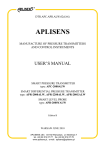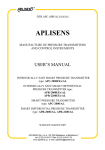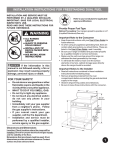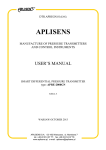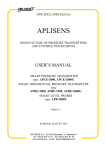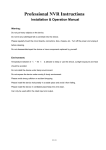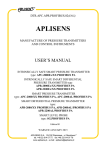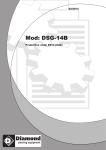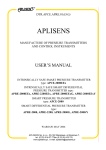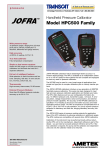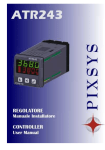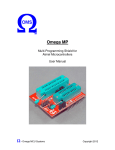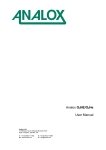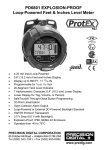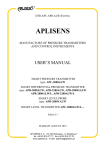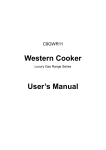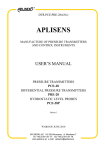Download APLISENS
Transcript
DTR.APC.APR.ALW.02(ENG) APLISENS MANUFACTURE OF PRESSURE TRANSMITTERS AND CONTROL INSTRUMENTS USER’S MANUAL SMART PRESSURE TRANSMITTER type: APC-2000ALW SMART DIFFERENTIAL PRESSURE TRANSMITTER type: APR-2000ALW, APR-2200ALW, APR-200GALW SMART LEVEL PROBE type: APC-2000YALW WARSAW JANUARY 2009 APLISENS JSC 03-192 Warszawa, ul. Morelowa 7 tel. +48 22 814 07 77; fax +48 22 814 07 78 www.aplisens.pl, e-mail: [email protected] 1 DTR.APC.APR.ALW.02(ENG) Symbols used Symbol i Description Warning to proceed strictly in accordance with the information contained in the documentation in order to ensure the safety and full functionality of the device. Information particularly useful during installation and operation of the device. Information particularly useful during installation and operation of a type Ex device. Information on disposal of used equipment BASIC REQUIREMENTS AND SAFE USE - The manufacturer will not be liable for damage resulting from incorrect installation, - - - - failure to maintain the device in a suitable technical condition, or use of the device other than for its intended purpose. Installation should be carried out by qualified staff having the required authorizations to install electrical and pressure-measuring devices. The installer is responsible for performing the installation in accordance with these instructions and with the electromagnetic compatibility and safety regulations and standards applicable to the type of installation. The device should be configured appropriately for the purpose for which it is to be used. Incorrect configuration may cause erroneous functioning, leading to damage to the device or an accident. In systems with pressure transmitters there exists, in case of leakage, a danger to staff on the side where the medium is under pressure. All safety and protection requirements must be observed during installation, operation and inspections. If a device is not functioning correctly, disconnect it and send it for repair to the manufacturer or to a firm authorized by the manufacturer. In order to minimize the risk of malfunction and associated risks to staff, the device is not to be installed or used in particularly unfavourable conditions, where the following dangers occur: - possibility of mechanical impacts, excessive shocks and vibration; - excessive temperature fluctuation, exposure to direct sunlight; - condensation of water vapour, dust, icing. Installation of intrinsic safety versions should be performed with particular care, in accordance with the regulations and standards applicable to that type of installation. The manufacturer reserves the right to make changes (not having a negative impact on the operational and metrological parameters of the products) without updating the contents of the technical manual. 2 DTR.APC.APR.ALW.02(ENG) CONTENTS APPENDIX Exd ..................................................................................................................................... 3 APPENDIX Exi ...................................................................................................................................... 6 INTRODUCTION.................................................................................................................................... 9 USER MATERIALS ............................................................................................................................... 9 APPLICATIONS AND MAIN FEATURES............................................................................................... 9 IDENTIFYING MARKS. ORDERING PROCEDURE............................................................................... 9 TECHNICAL DATA...............................................................................................................................10 I. II. 1. 2. 3. 4. 5. 5.1. APC..., APR...- COMMON PARAMETERS ................................................................................................................... 10 5.2. APC...- MEASUREMENT RANGES AND METROLOGICAL PARAMETERS. .......................................................................... 11 5.3. APR-2000ALW, APR-2200ALW MEASUREMENT RANGES AND METROLOGICAL PARAMETERS.................................... 12 5.4. APR–2000GALW, MEASUREMENT RANGES AND METROLOGICAL PARAMETERS.............................................................. 13 5.5. APR–2000YALW. MEASUREMENT RANGES AND METROLOGICAL PARAMETERS. ............................................................. 14 6. CONSTRUCTION.......................................................................................................................................14 6.1. MEASUREMENT PRINCIPLES, ELECTRONIC SYSTEM.................................................................................................... 14 6.2. CONSTRUCTION. ...................................................................................................................................................... 14 7. PLACE OF INSTALLATION .................................................................................................................15 7.1. GENERAL RECOMMENDATIONS .................................................................................................................................. 15 7.2. LOW AMBIENT TEMPERATURE. .................................................................................................................................. 15 7.3. HIGH MEDIUM TEMPERATURE. .................................................................................................................................. 16 7.4. MECHANICAL VIBRATION, CORROSIVE MEDIA. ........................................................................................................... 16 8. INSTALLATION AND MECHANICAL CONNECTIONS ........................................................................16 8.1. APC... INSTALLATION AND CONNECTIONS .................................................................................................................. 16 8.2. APR... INSTALLATION AND CONNECTIONS .................................................................................................................. 16 8.3. APR-2000GALW. INSTALLATION AND CONNECTIONS ................................................................................................ 17 8.4. APR-2000YALW. INSTALLATION AND CONNECTIONS ................................................................................................ 17 9. ELECTRICAL CONNECTION ...............................................................................................................17 9.1. GENERAL RECOMMENDATIONS .................................................................................................................................. 17 9.2. ELECTRICAL CONNECTIONS FOR APC..., APR... ........................................................................................................ 18 9.3. PROTECTION FROM EXCESS VOLTAGE........................................................................................................................ 18 9.4. EARTHING ................................................................................................................................................................ 18 10. SETTING AND REGULATION ..............................................................................................................18 10.1. TRANSMITTER RANGE,BASIC RANGE. DEFINITIONS .................................................................................................. 18 10.2. CONFIGURATION AND CALIBRATION ......................................................................................................................... 19 11. INSPECTIONS AND SPARE PARTS....................................................................................................28 11.1. PERIODIC INSPECTIONS .......................................................................................................................................... 28 11.2. UNSCHEDULED INSPECTIONS .................................................................................................................................. 28 11.3. CLEANING THE DIAPHRAGM SEAL, OVERLOADING DAMAGE ...................................................................................... 29 11.4. SPARE PARTS. ....................................................................................................................................................... 29 12. 13. 14. 15. 16. PACKING, STORAGE AND TRANSPORT. ..........................................................................................29 GUARANTEE .......................................................................................................................................29 ADDITIONAL INFORMATION ..............................................................................................................29 RELATED DOCUMENTS......................................................................................................................29 FIGURES. .............................................................................................................................................30 FIG. 1. APC...,APR... TRANSMITTERS – BLOCK DIAGRAM.................................................................................................. 30 FIG.2. ELECTRICAL CONNECTIONS FOR APC...,APR... TRANSMITTERS............................................................................... 30 FIG. 3. APC-2000ALW SMART PRESSURE TRANSMITTER ................................................................................................. 32 FIG. 4. APC..., APR.... DISPLAY ROTATION POSSIBILITY, CONFIGURATION BUTTONS. ......................................................... 33 FIG. 5. M-TYPE CONNECTOR WITH M20X1.5 THREAD ........................................................................................................ 34 FIG. 6. P-TYPE CONNECTOR WITH M20X1.5 THREAD......................................................................................................... 34 FIG. 7. CM30X2-TYPE CONNECTOR WITH FLUSH DIAPHRAGM WITH M30X2 THREAD ............................................................ 34 FIG. 8. PROCESS CONNECTIONS G1/2” AND G1”. ............................................................................................................. 35 FIG. 9. APR-2000ALW DIFFERENTIAL PRESSURE TRANSMITTER WITH C TYPE VENTED COVERS. ........................................ 36 FIG. 10. APR-2000ALW DIFFERENTIAL PRESSURE TRANSMITTER WITH A SINGLE DIRECT DIAPHRAGM SEAL (EXAMPLE). ....... 36 FIG. 11. EXAMPLE: HOW TO INSTALL THE APR-2200ALW TRANSMITTERS WITH REMOTE DIAPHRAGM.................................. 37 FIG. 12. EXAMPLE: HOW TO INSTALL THE APR-2000ALW TRANSMITTER ON A VERTICAL OR HORIZONTAL PIPE..................... 38 FIG. 13. EXAMPLE: HOW TO INSTALL THE APR-2000ALW TRANSMITTER WITH A VALVE MANIFOLD TO A 2” PIPE. .................. 38 FIG. 14. APR-2200ALW DIFFERENTIAL PRESSURE TRANSMITTER WITH TWO REMOTE DIAPHRAGM SEALS (EXAMPLES) ......... 39 FIG. 15. APR-2200ALW DIFFERENTIAL PRESSURE TRANSMITTER WITH DIRECT AND REMOTE DIAPHRAGM SEAL (EXAMPLES) 39 FIG. 16. EXAMPLE: HOW TO INSTALL THE APC..., APR... TRANSMITTER ............................................................................. 40 FIG. 17. APR-2000GALW SMART DIFFERENTIAL PRESSURE TRANSMITTER FOR LOW RANGES. ........................................... 40 FIG. 18. APR–2000YALW SMART LEVEL PROBE FOR PRESSURE TANKS. .......................................................................... 41 FIG. 19. THE EXPLOSION - PROOF JOINTS OF APC...,APR... TRANSMITTERS. ..................................................................... 42 FIG. 20. HOW TO LEAD THE CASING OF APC...,APR... TRANSMITTERS ............................................................................... 42 FIG. 21. ADDITIONAL EQUIPMENT FOR FITTING OF PRESSURE TRANSMITTERS. ..................................................................... 43 3 DTR.APC.APR.ALW.02(ENG) Appendix Exd0.2 I. APPENDIX Exd 1453 APC–2000ALW/XX PRESSURE TRANSMITTER, APR-2000ALW/XX, APR-2200ALW/XX, DIFFERENTIAL PRESSURE TRANSMITTERS, APR-2000YALW/XX LEVEL PROBE, Exd VERSION 1. Introduction 1.1. This “Appendix Exd.02” applies to transmitters of types APC-2000ALW/XX, APR-2000ALW/XX, APR-2200ALW/XXand APR-2000YALW/XX in Exd versions only, marked on the rating plate as shown in p.3 and denoted Exd in the Product Certificate. 1.2. The appendix contains supplementary information relating to the Exd (flame-proof) versions of mentioned transmitters. During installation and use of Exd transmitters, reference should be made to DTR.APC.APR.ALW.02(ENG) in conjunction with “Appendix Exd”. 2. Use of APC… APR… transmitters in dangers zones. 2.1. The transmitters are produced in accordance with the requirements of the following standards: EN 60079-0:2006, EN 60079-1: 2008, EN 60079-11:2007, EN 60079-26:2004,EN 61241-0:2006, EN 61241-1:2004, EN-61241-11:2006 2.2. The transmitters may operate in areas where there is a risk of explosion, in accordance with the rating of the explosion protection design: II 1/2G Ex ia/d IIC T5/T6 II 1/2D Ex ia D20/tDA21 T85/T100 KDB 08 ATEX 224X KDB 08ATEX 224X/1 marking T6 and T85 applies to range -40°C <Ta ≤ 45°C marking T5 and T100 applies to range -40°C <Ta ≤ 75°C 2.3. Transmitter category and hazard areas. The category 1/2G, contained within the rating, means that the transmitter may be installed within a type 1 or 2 hazard zone. The APC…, APR… process connections may connect to a 0 zone type (see the diagram below for an example). Zone 0 Zone 1 or 2 Safe area Pressure transmitter or differential pressure transmitter 3. Identifying marks. Flame-proof transmitters must have a rating plate containing the information specified in paragraph 4 of DTR.APC.APR.ALW.02(ENG) and also at least the following: - - CE mark and number of notified unit:, , mark, designation of explosion protection design, certificate number, temperature use range, year of manufacture. In place of XX letters in product rating plate will be write a pressure connection type symbols. 4 DTR.APC.APR.ALW.02(ENG) Appendix Exd0.2 4. User information. Together with the ordered transmitters, the user will receive: a. Product Certificate, b. Declaration of conformity, c. Copy of certificate – on request d. User’s Manual numbered: DTR.APC.APR.ALW.02(ENG) with Appendix Exd0.2. User can find them at www.aplisens.pl 5. Power supply and exploitation of transmitters. 5.1 i 5.2. i 5.3. The transmitter connecting should be made after introduction with present instruction content. Electrically transmitter should be connected according to scheme at p.6 Appendix Exd. Transmitter electrical installation should be realised with engineering standard requirements.Electrical connections of transmitters in danger zone should be made by people who have indispensable knowledge and experience in this branch. Transmitters should be supplied from DC electrical source with voltage max.45V from transformer feeders or other devices which have at least a strengthened isolation among primary and secondary windings in which don’t appear voltage higher than 250V. The duty of power supply installation with above mentioned requirements rests on user. Transmitters can be use in ambient temperatures (Ta) between -40°C <Ta ≤ 45°C for T6 class or between -40°C < Ta ≤ 75°C forT5 class. 5.4. Transmitter sensor diaphragm not should be subject on damage during installation and exploitation. The diaphragm is made from 316ss or Hastelloy thin foil and cannot be subject on medium which can entail its damage. 5.5. With regard on kind of casing material ( light alloy with large aluminium content), the user is obliged to assure, that possibility of hitting casing does not step out in place of transmitter installation. 5.6. In transmitter casing are two holes to assembly of cable intakes from thread M20x1,5 or 1/2 NPT. 5.7. Normally transmitters are delivered without installed intakes but with blank plugs (corks) in the second hole. They are at table 1 and table 2 at list of cable intakes and corks agreeable with production documentation and accepted by certificate station. Customer should install cable intakes according to tables 1 and corks according to tables 2 (if corks aren’t installed) or other accordance with flame-proof standards. 5.8. It is necessary apply a shield cable or without shield cable with round cross-section in protection from elastomer, not moisture absorbing, for example: YKSLY 2 * 1, YnTKSYekw 1 * 2 * 1, LIYCY 2 * In case of need of use cable about different building customer should co-ordinate this with transmitters manufacturer to choose intakes with cable diameter. 5.9. The general principles of connecting and the exploitation of transmitter in Exd realization should be compatible with principles and relating standards for Exd casing devices how in p.2.1, in this including also : EN600079-14, EN60079-17. 5.10. During service must be made a check of the tight fastening of covers and the cable intakes and the fastening of the cable in the intakes. The casing and supply line must be inspected for mechanical damage, and the transmitter rating plate for legibility. Periodic checks should also be made of the diaphragm, which should not carry signs of damage. During maintenance it is recommended that the threads of the covers be lubricated with non-acid vaseline. i i i Blocking cover method before unscrewing and plumbing possibility is shoved at fig 20. Because of the transmitter damage possibility, the ambient temperature should not be allowed to become higher than 80°°C, even when there is no explosion risk. It is not permitted to repair or otherwise interfere with the transmitter’s electrical circuits in any way. Damage estimation and repair possibility may be assessed by the manufacturer or another authorized party only. In danger zone don’t unscrew transmitter covers and don’t change the display position or its back lighting. 5 DTR.APC.APR.ALW.02(ENG) Appendix Exd0.2 6. How to connect Exd transmitters APC…, APR… Hazardous area Safe area + short-circuit( jumper) _ TEST + Ro ≥ 250Ω _ TEST _ +SIGNAL Ex power supply see p.5.. RD 240 Ω F1 F2 F3 PF RE PV F4 DEF GHI @%& ABC Fuse: In = 0,05A, Un = 250V according to EN 60127 F4 7 8 9 0 JKL MNO PQR +/ 4 5 6 S TU VWX YZ# 1 2 3 * Communicator . Fig. 2. i In case of transmitter calibration outside danger zone is possible communicator connecting to <SIGNAL+> and <TEST+> terminals. Transmitter is furnished in communication resistor (RD = 240Ω), closed with jumper at <SIGNAL-> and <TEST-> terminals installed by manufacturer. RD resistor can be use then, when it is necessary to communicate with transmitter from its terminals and the load resistance (Ro) in current loop is lover then 250Ω. Than <SIGNAL-> and <TEST-> terminals have to be open. Table 1. permitted cable intakes Type Producer Screw Feature Other marking No of certificate 501/423 HAWKE M20x1,5 Exd IIC dimension OS, O, A Baseefa 06 ATEX 0056X 501/421 HAWKE M20x1,5 Exd IIC dimension OS, O, A Baseefa 06 ATEX 0056X ICG 623 HAWKE M20x1,5 Exd IIC dimension OS, O, A Baseefa 06 ATEX 0058X 501/453 HAWKE M20x1,5 Exd IIC dimension OS, O, A Baseefa 06 ATEX 0056X * 501/453/RAC HAWKE M20x1,5 Exd IIC dimension OS, O, A Baseefa 06 ATEX 0056X * 501/453/Universal HAWKE M20x1,5 Exd IIC dimension OS, O, A Baseefa 06 ATEX 0057X * ICG 653 HAWKE M20x1,5 Exd IIC dimension OS, O, A Baseefa 06 ATEX 0058X * 8163/2-A2F STHAL M20x1.5 EXd IIC SIRA06ATEX1188X A2F, A2FRC, SS2K CMPProducts M20x1,5 Exd IIC SIRA06ATEX1097X E1FW, E1FX/Z, E2FW, E2FX/Z CMPProducts M20x1,5 Exd IIC SIRA06ATEX1097X * T3CDS, T3CDSPB CMPProducts M20x1,5 Exd IIC SIRA06ATEX1283X * PX2K, PXSS2K, PX2KX, PXB2KX CMPProducts M20x1,5 Exd IIC SIRA06ATEX1097X * Table 2. permitted corks Type Producer Screw Feature AGRO AG M20x1,5 Exd IIC 475 HAWKE M20x1,5 Exd IIC 477 HAWKE M20x1,5 Exd IIC *) for special cable only. Other marking No certificate 6 DTR.APC.APR.ALW.02(ENG) Appendix Exi II. APPENDIX Exi APC–2000ALW PRESSURE TRANSMITTER, APR-2000ALW, APR-2200ALW, APR-2000GALW DIFFERENTIAL PRESSURE TRANSMITTERS, APR-2000YALW LEVEL PROBE, Ex VERSION 1. Introduction 1.1. This “Appendix Exi” applies to transmitters of types APC-2000ALW, APR-2000ALW, APR-2200ALW, APR-2000GALW and APR-2000YALW in Ex versions only, marked on the rating plate as shown in 2.2 and denoted Ex in the Product Certificate. 1.2. The appendix contains supplementary information relating to the Ex versions of these transmitters. During installation and use of Ex transmitters, reference should be made to DTR.APC.APR.ALW.02(ENG) in conjunction with “Appendix Exi”. 2. Use of APC… APR… transmitters in danger zones. 2.1. The transmitters are produced in accordance with the requirements of the following standards EN 60079-0:2006, EN 60079-11:2007, EN 60079-26:2004 2.2. The transmitters may operate in areas where there is a risk of explosion, in accordance with the rating of the explosion protection design: II 1/2G Ex ia IIC T5/T6 FTZÚ 08 ATEX 0020 T5/T6 mark means that the temperature class is T5 or T6 depending on the working temperature of the transmitter, i.e. T6 for Ta ≤ 40°C or T5 for 40°C < Ta ≤ 65°C, and with power supply with rectangular characteristics, T6 for Ta ≤ 40°C, T5 for 40°C < Ta ≤ 80°C. 2.3. Transmitter category and hazard areas The category 1/2G, contained within the rating, means that the transmitter may be installed within a type 1 or 2 hazard zone. The APC…, APR… process connections may connect to a 0 zone type (see the diagram below for an example). Zone 0 Zone 1 or 2 Safe area Pressure transmitter or differential pressure transmitter 3. Identifying marks. Intrinsically safe transmitters must have a rating plate containing the information specified in paragraph 4 of DTR.APC.APR.ALW.02(ENG) and also at least the following: − − − − CE mark and number of notified unit:, , mark designation of explosion protection design, certificate number values of parameters such as. Ui, Ii, Pi, Ci, Li year of manufacture 7 DTR.APC.APR.ALW.02(ENG) Appendix Exi 4. User information. Together with the ordered transmitters, the user will receive: − Product Certificate, − Declaration of conformity, − Copy of certificate – on request − User’s Manual numbered: DTR.APC.APR.ALW.02(ENG) with Appendix Exi. User can find them at www.aplisens.pl 5. Permitted input parameters (based on data from the FTZÚ 08 ATEX 0020 certificate, and certification documentation). The transmitters should be powered via the associated power feeding and measurement devices provided with the relevant intrinsic-safe certificates. The parameters of their outputs to the danger zone should not exceed the limit power supply parameters for the below specified transmitters. 5.1 - for power supply with a “linear“ characteristic Ui = 28V Ii = 0,1A Pi = 0,7W for Ta ≤ 70°C i T5 Power supply with a “linear” characteristic may be e.g. a typical barrier with parameters Uo = 28V Io = 0.093A Rw = 300Ω. Ii Rw ID transmitter Io Uo Fig.1. Power supply from a source with “linear” characteristic 5.2. - for power supply with a “trapezial” characteristic Ui = 24V Ii = 0,05A Pi = 0,6W for Ta ≤ 80°C and T5 Example of power supply from a source with “trapezial” characteristic (see Fig. 2). transmitter Ii Io Ui Rw Uo ID Uq Fig. 2. Power supply from a source with “trapezial” characteristic Uq If Uo < 2 then parameters Uq, Io, Po are interrelated as follows: Uo(Uq – Uo) 4Po 4Po Uq = , Rw = Po = for Uo ≤ 1/2Uq 2 , Io Io 4Rw 5.3. - for power supply with “rectangular” characteristic Ui = 24V Ii = 0,025A Pi = 0,60W for Ta ≤ 80°C and T5 The supply of power from a source with a “rectangular” characteristic means that the voltage of the Ex power supply remains constant until current limitation activates. The protection level of power supplies with a “rectangular” characteristic is normally “ib”. The transmitter powered from such a supply is also a Ex device with protection level “ib”. Example of practical provision of power supply. – use a stabilized power supply with Uo=24V with protection level „ib” and current limited to Io=25mA. 5.4. Input inductance and capacity Ci = 20nF, Li = 1,1mH 8 DTR.APC.APR.ALW.02(ENG) Appendix Exi 5.5. Supply voltage min. 13,5VDC 5.6. Load resistance: from 28V linear supply Ro max [Ω] = 28V – 13.5V** – (300Ω* * 0,02A) 0,0225A for transmitter without display back lighting from a source with “trapezial” or “rectangular” characteristic supply Ro max [Ω] = Usup. – 13.5V 0,0225A *) barrier resistance **) 16,5V for transmitter with display back lighting 6. How to connect Ex transmitters APC…, APR… ? The transmitter and other devices in the measuring loop should be connected in accordance with the intrinsic-safety and explosion-safety regulations and the conditions for use in dangerous areas. Failure to observe the intrinsic-safety regulations can cause explosion and the resulting hazard to people. Hazardous area Safe area Ex-Milliammeter + Jumper mA _ TEST + Ro ≥ 250Ω _ TEST _ +SIGNAL a Ex power supply see p.5. RD 240 Ω F1 F2 F3 PF RE PV F4 DE F G HI @ %& ABC F4 7 8 9 0 JKL MNO PQR 4 5 6 +/ * S TU V WX YZ# 1 2 3 Aplisens KAP-03Ex Communicator . To measure the current in the transmitter without disconnecting the signalling circuit, connect a milliammeter to control sockets TEST+, TEST-. In hazardous areas, connections to the control terminals must be made using only instruments which are permitted to be used in such areas. i The transmitter is equipped in additional communication resistor RD = 240Ω During normal operation terminals <Signal –> and <Test –> are shorted. RD resistor is used when you wish to communicate with the transmitter locally (from its terminals) and Ro < 250Ω. Terminals <Signal –> and <Test –> must be opened. Transmitter electrical installation should be realised with engineering standard requirements. It is not allowed to repair or otherwise interfere with the transmitter’s electrical circuits in any way. Damage and possible repair may be assessed only by the manufacturer or another authorized party. 9 1. DTR.APC.APR.ALW.02(ENG) INTRODUCTION 1.1. This Manual is intended for users of APC-2000ALW smart pressure transmitters, APR-2000ALW, APR2200ALW, APR-2200GALW smart differential pressure transmitters, and APR-2000YALW smart level probe and their intrinsic-safety versions, containing the data and guidelines necessary to understand the functioning of the transmitters and how to operate them. It includes essential recommendations concerning installation and use, as well as emergency procedures. The parameters and information specified for transmitters identified herein with the sign APC..., APR... also apply to transmitters: APC-2000ALW, APR-2000ALW, APR-2200ALW, APR-2200GALW, APR-2000YALW and their explosion-proof versions, as well as all the variations differing by the type of the process terminals. Information on the transmitter sizes and the method of installation apply to both, all versions of transmitters. 1.2. Technical data for the diaphragm seals and for the APC... and APR... transmitters are contained in the catalogue cards “DIAPHRAGM SEALS”. 1.3. The transmitters comply with the requirements of EU directives as shown on the plate and with the relevant Declaration of Conformity. 1.4. Additional data on APC-2000ALW, APR-2000ALW, APR-2200ALW, APR-2000GALW and APR-2000YALW transmitters in Ex versions is contained in the appendix designed to DTR.APC.APR.ALW.02(ENG). Appendix Exi and in Exd versions in the appendix designed to DTR.APC.APR.ALW.02(ENG). Appendix Exd. During installation and use of the transmitters in Ex or Exd version, reference should be made to DTR.APC.APR.ALW.02(ENG) in conjunction with Appendix Exi or Exd. 1.5. The APC…, APR… transmitters are also made in a version which complies with the PED pressure directive, meet the requirements for category IV, and then carry additional markings as in 4.3. 2. USER MATERIALS Transmitters are delivered in single and/or multiple packs. Together with the transmitter are delivered: a) Product certificate, which is also as the warranty card b) Declaration of conformity - on request c) Copy of ATEX certificate – on request, d) User’s Manual numbered: DTR.APC.APR.ALW.02(ENG). Items b), c), d) are available at: www.aplisens.pl 3. APPLICATIONS AND MAIN FEATURES 3.1. The APC... smart pressure transmitters are designed to measure gauge pressure, vacuum pressure and absolute pressure of gases, vapours and liquids (including corrosive substances). Differential pressure transmitters type APR… are used to measure liquid levels in closed tanks, with static pressure up to 25MPa, or 32MPa for special versions and to measure differential pressure across constrictions such as filters and orifices. 3.2. The transmitters may be fitted with a range of types of process connectors, which enables them to be used in a variety of conditions such as thick or highly reactive media, high and low temperatures, etc. 3.3. APC..., APR... transmitters generate a 4...20mA output signal and a digital communication signal in a twowire system (current loop). The use of smart electronics enables regulation of the zero point, the measurement range, damping, radical conversion characteristic and other functions using an Aplisens KAP communicator or from a PC using a Hart/RS232 converter and Aplisens “Raport-01” configuration software. i 4. IDENTIFYING MARKS. ORDERING PROCEDURE 4.1. Every transmitter carries a rating plate containing at least the following information: CE mark, manufacturer name, transmitter type, serial number, pressure range, static pressure limit, output signal, power supply voltage. Version types and the method of specifying the desired product are described in the current “Information Cards” and the Catalogue. 10 i 5. DTR.APC.APR.ALW.02(ENG) 4.2. APC...APR...transmitters in Ex version or Exd version have additional markings as described in DTR.APC.APR.ALW.02(ENG) Appendix Exi or Exd. 4.3. The rating plates of APC… , APR… transmitters in versions compliant with the PED pressure directive contain the notified unit number 0062 next to the CE mark, as well as the designations of certificates number: CE-PED- H1D-APL003-04-POL rev.A for APC… transmitters CE-PED-H1D-APL 002-05-POL rev.B for APR… transmitters. TECHNICAL DATA. 5.1. APC..., APR...- Common parameters 5.1.1. APC..., APR... Electrical parameters Power supply Power supply for intrinsic-safe versions Output signal Communication 12* ÷ 45V DC in accordance with Appendix Exi. 4÷20mA realised via a 4÷20mA signal using KAP-03 communicator or RS/Hart modem and PC computer with Raport-01 software Resistance for communication 250÷1100Ω, min 240Ω Usup[V]-12V* 0,0225A Load resistance RLmax[Ω] = Usuply min. = 12*+ 0,0225xRL [V] *) 15V for transmitters with display backlight. Umin = f(Ro)without back lighting Vmin [V] Vmin [V] Umin = f(Ro) with back lighting 45 40 35 30 25 20 15 10 0 250 500 750 1250 1000 1500 45 40 35 30 25 20 15 10 0 250 500 Ro[Ω] 750 1000 Ro[Ω] Safe working area (grid) upper colour area. Output updating time Additional electronic damping Voltage for insulation testing Excess voltage protection 500ms 0...30s 500 VAC or 750 VDC, see p.9.3. see p.9.3. Response time on pressure stroke. pressure wyłączenie switch off ciśnienia I t d = 10 - 250ms td 20mA tc t c = 200ms t r = t d+ t c t r min. = 210ms t r max. = 460ms 9.89mA 4mA t APC...APR...transmitter, response time on pressure stroke tr measuring cycle 0,5s , damping = 0. t 1250 1500 1750 11 DTR.APC.APR.ALW.02(ENG) 5.1.2. APC..., APR... Permitted environmental conditions Operating temperature range -40°C ÷ 85°C (for PED version in accordance with p. 5.2.3.) Operating temperature range for intrinsic-safe versions in accordance with Appendix Exi Operating temperature range for flame-proof versions in accordance with Appendix Exd Medium temperature range Thermal compensation range Relative humidity Vibration during operation Exposure to direct sunlight -40°C ÷ 120°C – for direct measurement, for PED version in accordance with p. 5.2.3. over 120°C measurement with a transmission tube or diaphragm seal using -25º ÷ 80ºC, (-40º ÷ 80ºC for special version APC...) 0% ÷ 90% not recommended not recommended 5.1.3. APC..., APR... Construction materials Diaphragm seal for APC... Stainless steel 316L (00H17N14M2)(PED version) or Hastelloy C276 Diaphragm seal for APR... Stainless steel 316L (00H17N14M2)(PED version) or Hastelloy C276 Sensing module Stainless steel 316L (00H17N14M2) Liquid filling the interior the sensing module Silicone oil, chemically inactive liquid for measurement of oxygen uses. Connectors for APC... Stainless steel 316L (00H17N14M2) or Hastelloy C276 only for P, GP, CM30x2 C-type vented covers and connectors for APR..Stainless steel 316L (00H17N14M2) Electronics casing High pressure cast of aluminium alloy, lacquered with chemical-resistant oxide enamel, colour yellow (RAL 1003). 5.1.4. APC..., APR... Rating of Case Protection IP66 according to PN-EN 60529:2003. 5.2. APC...- Measurement ranges and metrological parameters. 5.2.1. APC..., Measurement ranges Nominal measuring range Minimum set range (FSO) 1. 0...1000bar (0...100MPa) 10bar (1MPa) 2. 0...300bar (0...30MPa) 3bar (300kPa) 3. 0...160bar (0...16MPa) 1,6bar (160kPa) 4. 0...70bar (0...7MPa) 0,7bar (70kPa) 5. 0...25bar (0...2,5MPa) 0,25bar (25kPa) 6. 0...7bar (0...0,7MPa) 0,07bar (7kPa) 7. -1...6bar (-100...600kPa) 300mbar (30kPa) 8. -1...1,5bar (-100...150kPa) 120mbar (12kPa) 9. 0...2bar (0...200kPa) 100mbar (10kPa) 10. 0...1bar (0...100kPa) 50mbar (5kPa) 11. -0,5...0,5bar (-50...50kPa) 50mbar (5kPa) 12. 0...0,25bar (0...25kPa) 25mbar (2,5kPa) 13. -100...100mbar (-10...10kPa) 20mbar (2kPa) 14. -15...70mbar* (-15...7kPa) 5mbar (0,5kPa) 15. 0...1,1bar abs (0...110kPa abs) 50mbar abs (5kPa abs) 16. 0...7bar abs (0...7MPa abs) 0,07bar abs (7kPa abs) 17. 0...25bar abs (0...2,5MPa abs) 0,25bar abs (25kPa abs) 18. 0...70bar abs (0...7MPa abs) 0,7bar abs (70kPa abs) * - only for transmitters without diaphragm seal, N° Rangeability 100:1 100:1 100:1 100:1 100:1 100:1 23:1 20:1 20:1 20:1 20:1 10:1 10:1 17:1 22:1 100:1 100:1 100:1 Overpressure limit (without hysteresis) 1200bar (120MPa) 450bar (45MPa) 450bar (45MPa) 140bar (14MPa) 50bar (5MPa) 14bar (1,4MPa) 14bar (1,4MPa) 4bar (400kPa) 4bar (400kPa) 2bar (200kPa) 2bar (200kPa) 1bar (100kPa) 1bar (100kPa) 0,5bar (50kPa) 2bar (200kPa) 14bar (1,4MPa) 50bar (5MPa) 140bar (14MPa) 12 DTR.APC.APR.ALW.02(ENG) 5.2.2. APC..., Metrological parameters Accuracy Long term stability Error due to supply voltage changes Thermal error Thermal error for the whole thermal compensation range max ± 0,075% for the basic range ≤ accuracy for 3 years (for the nominal measuring range) max ± 0,002%(FSO)/1V max ± 0,08%(FSO)/10ºC max ± 0,1% FSO/10°C for n°13, 14 ranges. max ± 0,25%(FSO) (max ± 0,4% FSO/10°C for n°13, 14 ranges. 5.2.3. APC…, APR… Metrological Parameters according to PED version. APC… , APR… transmitters, in the PED Pressure Directive versions, are produced with a measurement range in the interval from –100 kPa to 40MPa gage, or from 0 to 40MPa absolute, with the overpressure up to 44 MPa. Temperature limit -40 ÷ 1000C (-40 ÷ 1500C with s-Mazut connector). APC… pressure transmitters with the S-Mazut seal pressure connection, assembled with the PED version can be produced within the range–100 kPa to 10 MPa gage, or within the 0 - 10 MPa absolute, and the overpressure up to 11 MPa. Other parameters are as given in Tables 1, except that the ambient temperature error is 0.7 kPa/10ºC. The value of the pressure measurement range and related overpressure are given on rating plate and at Product Certificate. i 5.2.3. APC..., Pressure Connectors M-type connector with M20x1.5 thread – see figure 5a, available for PED version P-type connector with M20x1.5 thread – see figure 6a, available for PED version CM30x2-type connector with flush diaphragm – see figure 7a, G1/2 -type connector with G1/2” thread – see figure 8a, available for PED version GP -type connector with G1/2” thread, available for PED version CG1-type connector with G1” thread and flush diaphragm – see figure 8e, available for PED version RM-type connector with M20x1.5 thread and radiator RP-type connector with M20x1.5 thread and radiator G1/4-type connector with G1/4 thread, available for PED version 1/2NPT M type connector with 1/2NPT tread, available for PED version R1/2-type connector with R1/2 tread, available for PED version CG1/2-type connector with G1/2 tread and flush diaphragm, available for PED version other connection types by arrangement. 5.3. APR-2000ALW, APR-2200ALW Measurement ranges and metrological parameters. 5.3.1. APR-2000ALW, Measurement ranges N° 1 2 3 4 5 6 7 Nominal measuring range (FSO) 0...16bar (0...1,6MPa) 0...2,5bar (0...250kPa) 0...1bar (0...100kPa) 0...0,25bar (0...25kPa) -100...100mbar (-10...10kPa) -5...70mbar (-0,5...7kPa) -0,5...0,5bar (-50...50kPa) Minimum set range 1,6bar 0,25bar 70mbar 10mbar 10mbar 4mbar 0,1bar (160kPa) (25kPa) (7kPa) (1kPa) (1kPa) (0,4kPa) (10kPa) Rangeability 10:1 10:1 14:1 25:1 20:1 18:1 10:1 Overpressure limit Static pressure limit 250, 320bar (40bar for P-type connector) (250bar for version compliant with the PED pressure directive) 5.3.2. APR-2200ALW, Measurement ranges Nominal range (FSO) Minimum set range -160...160 mbar -0,5...0,5 bar -1,6...2 bar -1,6...16 bar 0,1 mH2O 0.5 mH2O 1,5 mH2O 1bar Vertical spacing Maximum configurable range dependent on the actual vertical spacing of of diaphragm seals. diaphragm seals. (m) [1,6+( vertical spacing of sealsx94)]mH2O ≤ 1,7m [5+(vertical spacing of sealsx1,04)]mH2O ≤ 6m [20+(vertical spacing of sealsx1,04)]mH2O ≤ 15m 16bar ≤ 15m Static pressure limit 40bar 40bar 40bar 40bar 13 i DTR.APC.APR.ALW.02(ENG) The maximum vertical diaphragm seal spacing shown in the table applies to level measurement, ensuring that it is possible to set the zero point of the transmitter when the tank is empty. For measurements of density or phase boundaries (in the sugar and chemical industries and in refineries) the vertical spacing of the diaphragm seals can be larger. 5.3.3. APR-2000ALW, APR-2200ALW Metrological parameters Accuracy Long term stability Error due to supply voltage changes Thermal error Thermal error for the whole thermal compensation range Zero shift error for static pressure* ± 0,075% (FSO) for the APR-2000ALW nominal range ≤ accuracy / 3 years ± 0,002%(FSO)/1V ± 0,08%(FSO)/10ºC ± 0,3%(FSO) ± 0,08 % (FSO)/10bar ± 0,01 % (FSO)/10bar (for range n°4) ± 0,03 % (FSO)/10bar (for range n°5, 6) Cut-off on radical characteristic curve up to10% of flow. * zeroing in static pressure conditions with zero differential pressure eliminate this error. 5.3.4. APR-2000ALW, Pressure Connectors APR-2000/ALW– C-type connector to mount together with a valve manifold see fig.9, available for PED version APR-2000/ALW with single direct diaphragm seal – as in the example (fig.10) or with other diaphragm seals in accordance with “DIAPHRAGM SEALS” catalogue cards. 5.3.5. APR-2200ALW. Pressure Connectors - diaphragm seals – see “DIAPHRAGM SEALS ”catalogue cards. 5.4. APR–2000GALW, Measurement ranges and metrological parameters. 5.4.1 APR–2000GALW. Measurement ranges N° 1 2 3 4 5 Nominal range (FSO) 0...25mbar (0...2500Pa) -2,5...2,5mbar (-250...250Pa) -7...7mbar (-700...700Pa) -25...25mbar (-2500...2500Pa) -100...100mbar (-10...10Pa) Minimum set range 1mbar (100Pa) 0,2mbar (20Pa) 1mbar (100Pa) 5mbar (500Pa) 20mbar (2kPa) Overpressure limit 350mbar 350mbar 350mbar 1bar 1bar Static pressure limit 1bar 1bar 1bar 1bar 1bar 5.4.2. APR–2000GALW. Metrological parameters. Nominal range Accuracy Set range Accuracy 0...25mbar -2,5...2,5mbar -7...7mbar -25...25mbar -100...100mbar ≤ ± 0,075 % ≤ ± 0,16 % ≤ ± 0,1 % ≤ ± 0,1 % ≤ ± 0,075 % 0...25mbar -2,5...2,5mbar -7...7mbar -25...25mbar -100...100mbar ≤ ± 0,4 % ≤ ± 1% ≤ ± 1,6 % ≤ ± 0,4 % ≤ ± 0,4 % ± 0,1 % (FSO)/ 10°C, max ± 0,4 % (FSO) for the whole thermal compensation Thermal error range Thermal compensation range -10 … 700C 5.4.3. APR–2000GALW. Construction materials M20x1,5/∅6x1 adapter brass Valve manifold ss316L Valve manifold adapter ss316L ¼ NPT connector brass, ss316L or galvanized St3S carbon steel (Other materials as given in 5.1.3 for APR...). 5.4.4. APR–2000GALW. Pressure Connectors - The terminals fit adapted to ø 6x1 plastic tubes, Valve manifold adapter or ¼ NPT connector- (see p. 8.3. and fig.17). 14 DTR.APC.APR.ALW.02(ENG) 5.5. APR–2000YALW. Measurement ranges and metrological parameters. 5.5.1. APR–2000YALW. Measurement ranges. N° Nominal range Minimum set range Static pressure limit 1 0... – 6000 mmH2O 2 0... – 1600 mmH2O 600 mmH2O 160 mmH2O 40 bar 5.5.2. APR–2000YALW. Metrological parameters. Nominal range N° Accuracy for basic range Accuracy for minimum range temperature error Zero shift error from static pressure * 1 2 ± 0,16 % ± 0,2 % ± 0,5 % ± 0,6 % 0,4 % for temperatures –25...+80°C 0,08 % / 10bar 0,1 % / 10bar * zeroing in static pressure conditions with zero differential pressure eliminate this error. Medium density range – up to 1,1 g/cm3 – (standard version) – over 1,1 g/cm3 – (special version by arrangement with APLISENS) 6. CONSTRUCTION 6.1. Measurement Principles, Electronic System. APC... electronic pressure transmitters and APR... electronic differential pressure transmitters work by converting changes in the resistance of a piezoresistance bridge, which are proportional to the measured pressure, into a standard current signal. The active sensing element is a silicon diaphragm with piezoresistors, separated from the medium by a sealing diaphragm and manometric fluid. The electronic system digitally processes the measurement signal and generates output signals: an analogue 4÷20 mA signal with a digital communication signal. A block diagram of the transmitter is presented in Figure 1. At the circuit input two analogue signals are provide: the measured pressure reflecting and the sensing module temperature. These signals are digitalized and provide to a microprocessor input which controls the transmitter’s operation. Using input data during the production process adjusts for thermal errors and carries out linearization. After digital processing, the signal is converted into an analogue 4÷20mA current signal again, with a superimposed digital communication signal. For communication with the transmitter via the signal line a special Aplisens KAP communicator, or a computer meeting the requirements given in 10.2.4, are used. The transmitter’s output is fitted with a radio-noise filter and other elements protecting against ESD. 6.2. Construction. The basic units of transmitter are: measuring sensor, in which pressure signal is converted into electric signal, and electronic units, transforming signal from measuring sensor into unified output signal. APC..., APR... transmitters are equipped in LCD display with LED back lighting, enabling reading two the process variables simultaneously as well as the unit process variable reading. The electronic board is closed in poly-carbonate casing. The casing construction enables turning of display by ±180 with 90°pitch. On the electronic casing the set of buttons is placed, used to local adjustment. The transmitters construction enables connecting of the separately compensated measuring sensor to separately compensated electronic board enables fast servicing at the plant. The electronic circuit of sensor has a galvanic separation from measuring line. Thanks of that construction the measurement susceptibility at interferences is reduced as well as the enlarged safety of work in the Ex and flameproof applications. The sensor memory contains 8 pressure shapes data bank which can (depending on factory settings) contain parameters describing behavior the same sensor in different pressures and/or temperatures ranges. In dependence from needs we can choose a needed bank of coefficients memory for transmitter work. APC..., APR...transmitters monitor work of their equipment as well as the calculation correctness and in case of rises of incorrigibility inform about mistakes displaying the announcement on LCD screen as well as putting out the alarm current in current loop. 15 DTR.APC.APR.ALW.02(ENG) 6.2.1. The pressure connectors may be fitted to the APC... sensing module as in figures 5a, 6a, 7a, 8 and other. The APR… transmitters have the sensing modules with two P-type connectors, or C-type connecting covers for installation on a valve manifold (figure 9). The sensing modules, for both types, are equipped with a diaphragm separating the internal part of the head from the measuring medium. 6.2.2. For measuring the pressure of dense, chemically reactive or hot media, the transmitter may be additionally fitted with various types of diaphragm seal depending on the type of medium and the conditions in which measurement is carried out (see catalogue cards “Diaphragm Seals). The diaphragm seal transmits the pressure obtained from the medium. The pressure is transmitted via a manometric fluid which fills the space between the diaphragm of the seal and the diaphragm of the sensing module. In the case of remote diaphragm seals, pressure is transmitted via a capillary linking the transmitter’s sensing module to the diaphragm seal. The seals construction depends on the medium properties and operating conditions for which they are intended. i Technical data relating to the diaphragm seals’ dimensions and operating conditions can be found in catalogue cards “DIAPHRAGM SEALS”. 6.2.3. The APR… transmitters may be fitted with an single direct diaphragm seal, mounted on the “+” pressure input of the sensing module, while the “–” input is a ¼NPT F connector (fig.10). The APR-2200ALW transmitter is fitted with two diaphragm seals and can be produced in two versions: with one direct diaphragm seal and one remote diaphragm seal (fig.15); with two remote diaphragm seals (fig.14). 6.2.4. In the case of the APR-2000GALW transmitters, the sensing module is located inside the transmitter casing. It is designed for the measurement of low pressures of non-aggressive gases, with a permitted overpressure of 1bar (or 350mbar). The basic (economy) version of this transmitter has ø6x1 elastic tubes terminals fitting, while the industrial version has adapters as shown in fig. 17. 6.2.5. APR-2000YALW smart level probe is equipped in diaphragm seal and flange to fixing on tank. 7. PLACE OF INSTALLATION 7.1. General recommendations 7.1.1. The smart pressure transmitter and differential pressure transmitter can be installed both indoors and outdoors. It is recommended that transmitters intended for outdoor use be placed in a box or under cover. 7.1.2. The place of installation should be chosen in such a way as to allow access to the device and to protect it from mechanical damage. In planning the installation of the transmitter and configuration of the impulse lines, attention should be paid to the following requirements: i - The impulse lines should be as short as possible, with a sufficiently large cross-section, and free of sharp bends, in order to prevent blockages; - Where the medium is a gas, the transmitters should be installed above the measuring point, so that condensation flows down towards the site of the pressure measurement; where the medium is a liquid or where a protective liquid is used, the transmitters should be installed below the place where the pressure measurement is taken; - The impulse lines should be inclined at a gradient of at least 10cm/m; - The levels of filling liquid in the impulse lines should be equal or kept constant difference, - The configuration of the impulse lines and the valve connection system should be chosen with regard to the measurement conditions and to requirements such as the need to reset the transmitters in position and the need for access to the impulse lines during water or gas removal and flushing. 7.1.3. Where there is a risk of heavy objects hitting the instrument (resulting, in extreme cases, in a part of the system with transmitters being torn off and medium leakage), appropriate means of protection should be applied for safety reasons and to avoid the possibility of sparkling or other, more appropriate location should be selected for the transmitter. 7.1.4. Attention should also be paid to possible installation faults which may lead to measurement errors, such as connections which are not tight, sediment blockage in lines which are too narrow, gas bubbles in a liquid line or liquid column in a gas line etc. 7.2. Low Ambient Temperature. When the solidification point of the liquid whose pressure is being measured is higher than the ambient temperature, steps should be taken to protect the measurement apparatus from freezing effects. 16 DTR.APC.APR.ALW.02(ENG) This is particularly important in the case open-air installations. Protection is obtained by filling the impulse lines with a mixture of ethylene glycol and water, or another liquid whose solidification point does not exceed the ambient temperature. Thermal insulation can protect the transmitter casing and lines only from brief exposure to low temperatures. Where the temperature is very low, the transmitter and impulse lines should be heated. 7.3. High Medium Temperature. The APC..., APR... transmitters may be used to measure media with temperatures of up to 120°C. (PED version see p 5.2.3). To protect the sensing module from temperatures higher then 120ºC, long impulse lines are used to disperse the heat and to lower the temperature of the sensing module. Where it is not possible to use impulse lines of the required length, APC..., APR... transmitters with remote diaphragm seals should be used (see “DIAPHRAGM SEALS ”catalogue cards). Data as per Appendix Exi or Appendix Exd.02 apply for the Ex or Exd version. 7.4. Mechanical Vibration, Corrosive Media. 7.4.1. The transmitter should be installed in a place which is free of vibrations. If vibrations are carried to the transmitter via the impulse lines, use should be made of elastic lines or a APC..., APR... transmitters with a remote diaphragm seal. 7.4.2. Transmitters should not be installed in places where the diaphragm, made of 316L steel 00H17N14M2), would be subject to corrosion by the medium being measured. If possible, transmitters with diaphragms made of Hastelloy C276 should be used, or other means of protection applied (e.g. in the form of a separating liquid) or transmitters with diaphragm seals adapted for measuring aggressive mediums according to “DIAPHRAGM SEALS” catalogue cards should be used). 8. i INSTALLATION AND MECHANICAL CONNECTIONS The APC..., APR... transmitters can operate in any position. When installed on an object with a high-temperature medium, it is advantageous to mount the transmitter in a horizontal position or downwards, in such a way that the transmitter is kept away from the rising hot air. For the small measurement ranges, the reading can be affected by the transmitter position, and by the impulse lines configuration, or the way in which they are filled with liquid. This error can be corrected using the zero-setting function. 8.1. APC... Installation and connections 8.1.1. The APC... transmitters can be mounted directly on the rigid impulse lines. For used connectors as in figures 5a, 6a and 7a, it is recommended that connection sockets be used as shown in figure 5b, 6b, 7b or 7c. It is recommended that sockets labeled “Socket CG1” and „Socket CG1/2” Fig. 8 are used for CG1 and CG1/2 connections, respectively. Besides, there are adapters for standard DIN50, (DIN40, DIN25, Clamp2”, Clamp1,5”, Clamp1”) type connections provided for readouts carried out in aseptic conditions using transmitters with CM30x2 connection. There are gaskets provided for every transmitter with P, CM30x2, CG1, CG1/2 and GP type connections. The gasket material is selected based on the pressure value, temperature and the type of the medium. 8.1.2. If the pressure is applied via a flexible plastic tube, the transmitter should be mounted on a support with Red Ø6-M reduction. The types of the impulse tubes (Fig.21) are to be selected depending on the pressure measured value and the medium temperature. 8.1.3. Tighten the transmitter in the socket with a torque suitable for the type of the gasket used and the pressure measured. 8.1.4. The APC… transmitter can be installed using a universal “AL” holder allowing to mount the transmitter in any position on the support or a horizontal or vertical pipe Ø35... Ø65 (Fig. 16). 8.2. APR... Installation and connections 8.2.1. The APR … transmitters can be mounted directly on rigid impulse lines. To connect the transmitter basic versions, with two M20 x 1.5 connectors (P-type connector), can use (for example) straight connecting elements with C type nuts. If elastic impulse lines are used, the transmitter should be additionally fastened to a pipe, panel or supporting construction. 17 DTR.APC.APR.ALW.02(ENG) 8.2.2. The APR-2000ALW and APR-2200ALW can be installed using the ø25 Fastener (fig.11) on a ø25 pipe or on a flat surface using an angle bracket. 8.2.3. The APR-2000ALW with connecting cover (C-type connector) (fig.9) are designed for installation on 3-valve or 5-valve manifolds to a 2” pipe or to a flat surface using “C-2” holder (fig.12), (fig.13). 8.3. APR-2000GALW. Installation and connections 8.3.1. The “economy” version of the APR-2000G transmitter can be mounted on a wall, panel or other stable construction, using a clamp with Ø9 holes (Fig.17). The transmitter is fitted with connectors which fit to a Ø6x1 elastic impulse tube. When the measuring impulse is transmitted via a metal terminal with M20 x 1.5 connector, an adapter is used between the M20 x 1.5 thread and the Ø6x1 terminal. Transmitters should be installed in a vertical position. The way of impulse line leading should enable the vapour flowing towards the pipeline. Where there is a significant difference between the height at which the transmitter is mounted and the height of the impulse source, particularly if the measurement range is small, the reading may fluctuate depending on the temperature difference between the impulse lines. This effect can be reduced by ensuring that the impulse lines run side by side. 8.3.2. The APR-2000GALW transmitter can also be fitted with an adapter (Fig.17) creating a C-type connector, designed for installation on a 3-valve or 5-valve manifold. Aplisens can also supply ready transmitters mounted on valves. 8.4. APR-2000YALW. Installation and connections The APRE-2000YALW level probes installed in places where liquid levels are measured in closed tanks, with access to medium from top of tank as fig.15 and 10.2.6. Level probes should be installed in a vertical position. Pressure may be transmitted to the installed device only after checking that it has a measurement range which properly corresponds to the value of the measured pressure, that gaskets have been properly selected and fitted, and the connectors have been properly screwed tight. Attempts to undo the screws or fixing connector pipes on a transmitter under pressure may cause the medium to leak and create hazards for the personnel. When disassembling the transmitter, it is necessary to disconnect it from the process pressure or bring the pressure to atmospheric level, and to take particular care and precautions in case of media which are highly reactive, caustic, explosive or otherwise hazardous to personnel. If necessary, rinse out this part of the system. Transmitters with flange diaphragm seals are to be installed on the corresponding counter flanges on the facility. It is recommended that the user matches the screw joints material to the pressure, temperature, flange material and seal to ensure tightness of the flange joint in the expected operating conditions.. Screws complying with ISO 261 are to be used for flanges used in the APC..., APR... transmitters. Additional data concerning the diaphragm seals are specified in the “DIAPHRAGM SEALS” catalogue cards. i 9. ELECTRICAL CONNECTION 9.1. General recommendations 9.1.1. It is recommended that twisted pair cabling be used for the signal lines. If the transmitter and signal line are subject to a large amount of electromagnetic interference, then shield pair cable should be used. The signal wires should not run alongside network power supply cables or near to large electrically-powered devices. The devices used together with the transmitters should be resistant to electromagnetic interference from the transmission line in accordance with compatibility requirements. It is also beneficial to use anti-interference filters on the primary side of the transformers, the power supplies used for the transmitters and apparatus used in conjunction with them. i 9.1.2. Wet or rising damp inside transmitter can cause its damage. When the isolation of the wires in the packing gland is ineffective (for example, when single wires are used) the opening of the gland should be carefully sealed with an elastic sealing compound to obtain IP66 protection. It is useful to form the segment of the signal wire leading to the packing gland into a protective loop to prevent condensation from running down in the direction of the gland. 18 DTR.APC.APR.ALW.02(ENG) 9.2. Electrical connections for APC..., APR... i The APC..., APR... transmitters are to be connected as shown in fig. 2a – 2d. In APC..., APR... transmitters, a 240Ω resistor is permanently fitted in series in the transmitter’s current circuit and blocked up with jumper between <SIGNAL –> and <TEST –> as shown in fig.2a and 2b. When the resistance in the current loop is lower than 240Ω it is necessary to jumper disassemble to Hart communication. 9.3. Protection from excess voltage 9.3.1. The transmitters may be in danger from excess voltage caused by connection faults or atmospheric electrical discharge. Protection from excess voltage between the wires of the transmission line is provided by TVS diodes installed in all types of transmitter (see the table, column 2). 9.3.2. In order to protect against excess voltage between the transmission line and the casing or earth (not prevented by the diodes connected between the transmission wires), additional protection is provided in the form of plasma surge arresters (see the table, column 3). Also external protective devices may be used, e.g. the UZ-2 Aplisens system, or others. When the transmission lines are long, it is advantageous to use one protective device near the transmitter (or inside it), and another near entry points to other devices used in conjunction with it. Internal protection of transmitters: 1 2 Type of Protection between wires (TVS transmitter diodes) – permitted voltage APC..., APR... 68V DC (39V DC for Exi version) 3 Protection between wires and earth and/or casing – type of protection, permitted voltage Plasma surge arresters - 100V DC (Not applicable to Ex version). 9.3.3. The voltage in the protective elements must not exceed the maximum permitted values given in columns 2 and 3 of the table. i The insulation test voltages (500V AC or 750V DC) given in 5.1.1 refer to transmitters plasma surge arresters - such protection is not used in Exi versions of transmitters. 9.4. Earthing The transmitters are fitted with internal and external earth terminals. 10. SETTING AND REGULATION APC..., APR... transmitters are factory calibrated to the range stated in the order or to the basic range. After installation, the transmitter’s zero-point may move and require adjustment. This applies particularly in cases where the measurement range is small, where the impulse lines are filled with a separating liquid or where APC..., APR... transmitters are used with remote diaphragm seals. 10.1. Transmitter Range,Basic Range. Definitions 10.1.1. The maximum range of pressure, or differential pressure, which the transmitter can measure is called the “basic range” (for specifications of basic ranges see section 5.2.1, 5.3.1, 5.3.2, 5.4.1, 5.5.1). The width of the basic range is the difference between the upper and lower limits of the basic range. The internal characteristic conversion curve for the basic range is coded in the transmitter’s memory. This is the reference curve used when making any adjustments which affect the transmitter’s output signal. 10.1.2. When the transmitter is in use the term “set range” is used. The set range is the range whose lower end-point corresponds to an output current of 4mA and whose upper end-point corresponds to a current of 20mA (or 20mA and 4mA respectively when the conversion curve is inverted). The set range may cover the whole of the basic range or only a part of it. The width of the set range is the difference between its upper and lower end-points. The transmitter may be set to any range within the basic range of pressure values, subject to the restrictions set out in the table in section 5.2.1, 5.3.1, 5.3.2, 5.4.1, and 5.5.1. 19 DTR.APC.APR.ALW.02(ENG) 10.2. Configuration and Calibration 10.2.1. The transmitter has features which enable metrological and identification parameters to be set and altered. The configurable metrological parameters affecting the transmitter’s output current include the following: a) unit in which the measured pressure is expressed on the display b) upper end-point of the set range c) lower end-point of the set range d) time constant e) type of characteristic curve: linear or radical Parameters of an informational nature which cannot be altered include the following: f) upper limit of the basic range g) lower limit of the basic range h) minimum range 10.2.2. Other identification parameters, not affecting the output signal, include: device address, device type code, factory identification code, factory device code, number of preambles (3÷20), UCS, TSD, program version, electronics version, flags, serial number, label tag, description tag, date tag, message, record number, sensing module number. The process of setting the parameters listed in 10.2.1 and 10.2.2 is called “Configuration”. 10.2.3. It is possible to carry out a “pressure zeroing” procedure, for example to compensate for measurement deviation caused by a change in position diuring the transmitter installation. The transmitter may also be calibrated, by taking readings with the input pressure controlled using a standard device. This process and zero-point adjustment are called “Calibration”. 10.2.4. Configuration and Calibration of the transmitter are carried out using an Aplisens KAP communicator, certain Hart communicators or a PC with Hart/RS232 converter and Aplisens Raport-01 software. Together with the “RAPORT-01” configuration software there is a „INTERVAL LINEARIZATION” software supplied to enable the input of 21-point nonlinear functional characteristics to the transmitter. A description of the functions of the KAP communicator is contained in the KAP Communicator Operating Manual, and information on the Hart/RS232 converter can be found on the Hart/RS232/01 Converter information sheet. 10.2.5. Local configuration of transmitters If the option of local configuration is active, operator can change transmitter set using buttons being below display. The access to buttons will get after unscrewing the side cover. Then we can also change the display position turning it with 900 angle position. (see fig. 4). If the option of local configuration is active, operator can change transmitter set using buttons being below display. To enter at the local set change of the work mode, you should press one button and hold its about 4s. If using buttons can't change the transmitter configuration , the local transmitter configuration is switched of and to its switching on is necessary to use the KAP 3 Calibrator. The buttons are signed with symbols: [↑] [↓] [◙] After pressing by 4 seconds any of buttons there will appear on display “EXIT”. If we will confirm this announcement across pressing and holding button [[◙] by 1 sec, we will go out from the local change of the MENU set. If we will not confirm, we can move in MENU and change interesting us parameters. The time of pressing [↑]] [↓] [◙] has to be longer than 1s. Pressing button [↑] moves up in tree's structure MENU Pressing button [↓] moves down in tree's structure MENU Pressing [◙]confirms choice and leads change. | EXIT (First announcement which will see after inclusion of Menu Local. | If you will confirm this option, you will go out from Local Menu | and you will come back to continue of measuring) PV ZERO_________ \ | BACK (Return to Local Menu. If you will confirm this option, | | you will come back to main tree of Local Menu) | | | | | PV ZERO (Pressure zeroing. If you will confirm this option, | transmitter will confirm the party of command | by the "DONE" announcement or the proper number of error will | notify.) | 20 SET LRV_________ | \ | BACK | | | | | BY PRESsure | | | | | | | BY VALUE | | | | | | | | | | SET URV___ | | | | | | | | | | | | | | | | | | | | | DTR.APC.APR.ALW.02(ENG) (The Setting of the range of the set LRV beginning) (Return to Local Menu. If you will confirm this option, you will come back to main tree of Local Menu) (Setting LRV across setting pressure. If you will confirm this option, transmitter will confirm the party of command by the "DONE" announcement or the proper number of error will notify) (Setting the LRV across inscribing of value.) (After confirmation will display current LRV value before the passage in mode of edition) ↓ ↓ +/(Choose and confirm sign introduced parameter) ↓ 00000 (Introduce in sequence , digit after digit, 5 digital number with point or without point. After confirmation the last 5 digit of the parameter transmitter will confirm the party of command by the "DONE" announcement or the proper number of error will notify. The parameter will be written down in units "UNIT") (The setting of the end of the set URV range) \ BACK (Return to Local Menu. If you will confirm this option, | you will come back to main tree of Local Menu) | BY PRESsure (Setting URV across setting pressure. If you will confirm this | option, transmitter will confirm the party of command by the | "DONE" announcement or the proper number of error will notify | BY VALUe (Setting the URV across inscribing of value) \ (After confirmation will display current URV value before the passage in mode of edition) ↓ ↓ +/(Choose and confirm sign introduced parameter) ↓ 00000 (Introduce in sequence, digit after digit, 5 digital number with point or without point. After confirmation the last 5 digit of the parameter transmitter will confirm the party of command by the "DONE" announcement or the proper number of error will notify. The parameter will be written down in units "UNIT") 21 UNIT______ | | | | | | | | | | | | | | | | | | | | | | | | | || \ BACK | | | | | IN_H2O IN_HG FT_H2O MM_H2O MM_HG PSI BAR MBAR G/SQCM KG/SQCM PA KPA TORR ATM M_H2O MPA INH20@4 MMH2O@4 |DAMPING________ | \ | BACK | | | | | | | | | | | | 0 [S] | 2 [S] | 5 [S] | 10 [S] | 30 [S] | 60 [S] | | TRANSFEr_______ | \ | BACK | | | | | | | | | | | | | LINEAR | SQRT | SPECIAL | SQUARE | | DTR.APC.APR.ALW.02(ENG) (Return to Local Menu. If you will confirm this option, you will come back to main tree of Local Menu) (Confirm one of the following characteristics across longer press button ◙. After parameter confirmation transmitter will confirm the party of command by the "DONE") (Setting of the solid temporary suppression of the process variable) (Return to Local Menu. If you will confirm this option, you will come back to main tree of Local Menu) (Confirm one of the following values time constant across longer press button ◙. After parameter confirmation transmitter will confirm the party of command by the "DONE") (Setting of the current output form) (Return to Local Menu. If you will confirm this option, you will come back to main tree of Local Menu) (Confirm one of the following characteristics across longer press button ◙. After parameter confirmation transmitter will confirm the party of command by the "DONE") (Linear) (square root) (user’s ) (square) 22 % SQRT______ | \ | | | | | | | | | | | | | LCD1 VARiable__ | | | | | | | | | | | | | | | LCD2 VARiable | | | | | | | | | | | | | | | | | | | | DTR.APC.APR.ALW.02(ENG) (square root characteristic cut-of point setting) BACK | | | | | | 0 % 1 % 2 % 3 % 4 % 5 % (Return to Local Menu. If you will confirm this option, you will come back to main tree of Local Menu) (Confirm one of the following percent value across longer press button ◙. After parameter confirmation transmitter will confirm the party of command by the "DONE") (Type of the process variable displayed on LCD1) \ BACK | | | | | | CURRENT | | PERCENT (Return to Local Menu. If you will confirm this option, you will come back to main tree of Local Menu) (Confirm one of the following option across longer press button ◙. After parameter confirmation transmitter will confirm the party of command by the "DONE") (On LCD1 will displayed current value in current loop) (The percent value output signal will displayed on LCD1) (Type of the process variable displayed on LCD2) \ BACK | | | | | | | PRESSURE | USER | | UNIT | | NO UNIT (Return to Local Menu. If you will confirm this option, you will come back to main tree of Local Menu) (Confirm one of the following option across longer press button ◙. After parameter confirmation transmitter will confirm the party of command by the "DONE") (The pressure value will displayed on LCD2) (The user’s units will displayed on LCD2) (The current unit or user’s unit alternately with process variable will displayed on LCD2) (The current unit or user’s unit alternately with process variable will not displayed on LCD2) 23 LCD2 DP_________ | \ | BACK | | | | | | | | | | | | | XXXXX• | | | XXXX•X | | | XXX•XX | | | XX•XXX | | | •XXXXX | FACTORY________ | \ | BACK | | | | | | | | | | | | | RECALL | | RESET____ \ BACK | | | | | | RESET DTR.APC.APR.ALW.02(ENG) (The process variable point position on LCD2) (Return to Local Menu. If you will confirm this option, you will come back to main tree of Local Menu) (Confirm one of the following option across longer press button ◙. After parameter confirmation transmitter will confirm the party of command by the "DONE") (Come back to factory setting) (Return to Local Menu. If you will confirm this option, you will come back to main tree of Local Menu) (Confirm the command as bellow across longer press button ◙. After parameter confirmation transmitter will confirm the party of command by the "DONE") (The program enforcement of the transmitter restart) (Return to Local Menu. If you will confirm this option, you will come back to main tree of Local Menu) (Confirm the command as bellow across longer press button ◙. After parameter confirmation transmitter will confirm the party of command by the "DONE") 24 DTR.APC.APR.ALW.02(ENG) Local Menu, error reports. During executing in Local Menu some functions, LCD2 announcement can be displayed on the screen. The error displaying evidences about no realization of command of Local Menu. The shortened description of errors announcements is showed below. ERR_L07 [in_write_protected_mode]. Error will ensue out when we try to change setting in Local Menu, but transmitter is protected before recording. To to make the change of setting with Local Menu using, transmitter has to have the included service of Local Menu as well as switched off protection before record. These parameters modification is possible by using KAP -03 communicator, RAPORT program or software using library EDDL. • default setting: Local Menu service switched on protection before record switched off ERR_L09 [applied_process_too_high]. Error will ensue out when given parameter (pressure) exceed admissible value. Zeroing or the range setting verifying is necessary. ERR_L10 [applied_process_too_low]. Error will ensue out when given parameter (pressure) will too low. Zeroing or the range setting verifying is necessary. ERR_L14 [span_too_small]. Error will ensue out when in result of setting range executing change the width of the range will be smaller than admissible. ERR_L16 [acces_restricted]. Error will ensue out when the service of Local Menu is switched off, and the user tries to call out the Menu Local service. You should switch on the service of Local Menu with the KAP-03 communicator, RAPORT program, or software using library EDDL. Warning!, ERR_L16 announcement can be displayed as well by zeroing attempt of the absolute transmitter . WNG_L14 [WARNING!, new Lower Range Value Pushed !] Error will ensue out when the end of range set ( the URV) change will cause the change of the range set beginning (LRV). 25 DTR.APC.APR.ALW.02(ENG) 10.2.6. Remote configuration Remote configuration is possible with KAP-XX communicator or PC software. Measuring circuit should be in accordance with the fig. 2. 10.2.7. LCD display configuration. The LCD display configuration can do in dependence from needs. Changes of the display options in local MENU are possible using buttons or remote way using communicator, or the PC software. If it is necessary the display switching off is also possible. The display switching of function is possible with using communicator or PC software only. The APC..., APR... transmitter display exterior is as bellow. There 3 main displays are visible: • Bargraf (display line) – the current output grade line guidance display. At 0% output guidance, the line units are not blacked. As the guidance is rise the next units will blacked. One unit correspond to 10% guidance. At 100% guidance all line units will blacked. • LCD1 – the current or guidance percent preset range display. In accordance with display configuration the current value in 4 -20 mA current loop, or percent guidance preset range is possible to display. When current is displayed , symbol „c” before value is visible. • LCD2 – the measured pressure digital value display; the calibrated pressure value according to user”s units display; the process variable units or user’s units display; the MENU announcement and other information or warning announcement display. In the case the digital pressure value or the calibrated pressure value display, the sign „–„ can be visible before displayed value. The decimal point position is possible to set in local MENU or remotely. In the case of display overfilling (when the displayed value will exceed the „99999”) the „COMMA” displays. When the pressure value limits will exceeded the „ UNDER „ or „ OVER „ are displayed depending on exceeding direction. The pressure unit or user’s unit can be displayed alternatingly with digital value displaying in 10s indicate digital value cycle, or 1s indicate digital value cycle. If it is necessary the display unit switching off in local MENU is possible, or with communicator, or PC software using. The transmitter makes possible rescale on the user's individual the pressure value. To make this is necessary with using communicator or PC software write the corresponding to beginning and to end values of setting range as well as write the own unit name. After activating user's mode the rescale value will be visible on display. Local display is equipped in backlight, switching on and switching off with jumper on electronic board. 26 DTR.APC.APR.ALW.02(ENG) 10.2.8. Configuration of the APR-2200ALW transmitters to measure the level, density of liquid and phase boundary Configuration of the APR-2200ALW transmitters to measure the level of liquid in a tank. Configuration of the APR-2200ALW transmitters to measure density of liquids. 27 DTR.APC.APR.ALW.02(ENG) 28 DTR.APC.APR.ALW.02(ENG) 10.2.9. Configuration of the APR-2200YALW smart level probes Mechanical installation On the flange of the tank Upper equalization hole Lower equalization hole . Diaphragm seal unit 11. INSPECTIONS AND SPARE PARTS. 11.1. Periodic inspections Periodic inspections should be made in accordance with the regulations to which the user is subject. During inspection, the pressure connectors should be checked for loose connections and leaks, the electrical connectors should be checked with regard to tightness and the state of the gaskets, packing glands, and the diaphragm seals should be checked for tarnishing and corrosion. Check the characteristic conversion curve by following the procedures for “Calibration” and, where appropriate, “Configuration”. 11.2. Unscheduled inspections i If the transmitters are installed in a location where they may be exposed to mechanical damage, excess pressure, hydraulic impulses or excess voltage, or the diaphragm may be in danger from sedimentation, crystallization or erosion, inspections should be carried out as required. Where it is found that the signal in the transmission line is absent or its value is incorrect, a check should be made on the line and its terminal connections. Check whether the values of the supply voltage and load resistance are correct. If a communicator is connected to the power supply line of the transmitter, a fault in the line may be indicated by the message “No response” or “Check connection”. If the line is in order, check the operation of the transmitter. 29 DTR.APC.APR.ALW.02(ENG) 11.3. Cleaning the Diaphragm Seal, Overloading Damage 11.3.1. Sediment and dirt which have formed on the diaphragm in the course of operation must not be removed by mechanical means, as this may damage both the diaphragm and the transmitter itself. The only permitted method is the dissolving of sediment. 11.3.2. Sometimes transmitters malfunction due to damage caused by overloading, e.g. in case of: - application of excessive pressure; - freezing or solidification of the medium; - action of a hard object, such as a screwdriver, on the diaphragm. Usually in such cases the symptoms are such that the output current falls below 4mA or rises above 20mA, and the transmitter fails to respond to input pressure. 11.4. Spare parts. Parts of the transmitter which may be subject to wear or damage and require replacement: cover gasket i Other listed parts, due to the specific features and requirements of explosion-protected devices, may be replaced only by the manufacturer or by a firm authorized by the manufacturer. 12. PACKING, STORAGE AND TRANSPORT. The transmitters should be packed singly or in sets, in such a way as to protect them from damage during transportation. The transmitters should be stored in multiple packs under cover, in a place free of vapours and reactive substances, with an air temperature between +5°C an d +40°C, and relative humidity of not more than 85% . Transmitters with uncovered diaphragm or seal connectors, stored without packaging, should have covers to prevent damage to the diaphragm. During transportation, the transmitters should be packed and secured so as to prevent them from shifting. Any means of transport may be used, provided direct atmospheric effects are eliminated. 13. GUARANTEE The manufacturer guarantees the proper operation of the transmitters for a period of 24 months from the date of purchase and servicing provided under the guarantee and following the guarantee period. In the case of special versions, the guarantee period shall be agreed by the manufacturer and the user, but shall not be less than 12 months. 14. ADDITIONAL INFORMATION The manufacturer reserves the right to make constructional and technological changes which do not lower the quality of the transmitters. 15. RELATED DOCUMENTS. - “KAP– Communicator User’s Manual” supplied with the Aplisens communicator. Hart/RS232/01 Converter information sheet. Raport-01” software. „INTERVAL LINEARIZATION ” software. 30 DTR.APC.APR.ALW.02(ENG) 16. FIGURES. Memory 1 Sensing module Input circuit Converter a/c sor ces Pro Output circuit + D Noise filter Power supply/ measurement system _ 2 Load resistance min.250 Ω Communicator Modem Fig. 1. APC...,APR... transmitters – block diagram. Communicator or modem electrical connections to transmitter measuring lines. For successful communication with transmitter the resistance in measuring loop, behind connected device to communication, should be higher than 250Ω. If necessary install the additional resistor in the line. The communicator or modem connecting ways to the measuring loop are presented at diagrams. During increasing of resistance in the measure loop at making the good transmission, is necessary to make sure that the tension falls at sum resistances in the loop don't lower minimum tension at transmitter terminals. (see p.5.1.1) Fig.2. Electrical connections for APC...,APR... transmitters RS 232 BELL 202 RAPORT JUMPER 4÷20 mA + 240 Ω Communicator SIGNAL Ro _ -TEST +TEST mA Power supply + Current loop F1 F2 F3 F4 PF RE PV F4 GHI @%& ABC DEF 7 8 9 0 JKL MNO PQR +/ 4 5 6 STU VWX YZ# 1 2 3 * . Switch box Fig.2a. The link of transmitter and communicator or modem to current line by the switch box ( in case of the resistance in current loop is higher than 250Ω). 31 DTR.APC.APR.ALW.02(ENG) RS 232 RAPORT BELL 202 JUMPER 4÷20 mA F2 F3 PF RE PV F4 ABC DEF GHI @%& 7 8 9 0 JKL MNO PQR +/ 4 5 6 STU VWX YZ# 1 2 3 240 Ω * . _ To measure the transmitter current without disconnecting the measuring loop, connect a milliammeter to control terminals <Test -> and <Test +>. F4 Communicator F1 + SIGNAL Ro -TEST +TEST mA Power supply + Current loop Fig.2b. The link of transmitter and communicator or modem to <SIGNAL+> <SIGNAL-> transmitter terminals in case of the resistance in current loop is higher than 250Ω. RS 232 RAPORT BELL 202 JUMPER 4÷20 mA F1 F2 F3 F4 PF RE PV F4 GHI @%& ABC DEF 7 8 9 0 JKL MNO PQR 4 5 6 +/ * STU VWX YZ# 1 2 3 . 240 Ω _ -TEST + SIGNAL Ro Communicator +TEST mA Power supply + Current loop Fig.2c. The link of transmitter and communicator or modem to <SIGNAL+> <TEST+> transmitter terminals in case of the resistance in current loop is smaller than 250Ω. 32 DTR.APC.APR.ALW.02(ENG) RS 232 BELL 202 RAPORT JUMPER 4÷20 mA F1 F2 F3 F4 PF RE PV F4 GHI @%& ABC DEF 7 8 9 0 JKL MNO PQR +/ 4 5 6 STU VWX YZ# 1 2 3 * . - 240 Ω _ -TEST + SIGNAL Ro Communicator +TEST mA Power supply + Current loop Fig.2d. The link of transmitter and communicator or modem to <SIGNAL+> <SIGNAL-> transmitter terminals in case of the resistance in current loop is smaller than 250Ω. If Ro in current loop is lower than 250Ω is necessary to connect 240Ω resistor to current loop by remove jumper from <SIGNAL-> and <TEST-> terminals. After communication jumper should cam back at its place. Lock preventing rotation of the casing 91,5 The electronic circuits and display side Earthing terminal Fig. 3. APC-2000ALW smart pressure transmitter M20x1,5 packing gland Cable ∅5...∅10 The electrical terminals side 133 18 38,5 132 FIELD TERMINALS 18 2 x M6 33 DTR.APC.APR.ALW.02(ENG) ±180o with 900 pitch unscrew the display cover and casing display screws Configuration buttons Move the electronic unit from transmitter casing, take up the upper part of the casing with display from the catch and revolve its to left or to right to the display setting at needed position. Rotation possibility ±1800 with 90° pitch. Screw on the display unit screws and display cover. Fig. 4. APC..., APR.... display rotation possibility, configuration buttons. Jumper in radial position (as at photo) –back lighting off; jumper in circular position –back lighting on. Fig. 4a. Back lighting jumper view at transmitter electric board (unit display back side). 34 DTR.APC.APR.ALW.02(ENG) 19 M20x1,5 1,25 25 3 ∅6,5 M20x1,5 ∅6 ∅4 5 Fig.5a. M-type connector with M20x1.5 thread 2 Fig.5b. Socket for M-type connector min.15 M20x1.5 ∅25,1 +0,1 ∅25 M20x1.5 ∅12 1,25 15 2 diaphragm seal Fig.6a. P-type connector with M20x1.5 thread Fig.6b. Socket for P-type connector TOP 16 min.15 30° ∅50 2 ∅25,3 ∅35,1 M30x2 2 M30x2 ∅35,1 +0,1 ∅35 1,25 15 M30x2 2 diaphragm seal Fig.7a. CM30x2-type connector with flush diaphragm with M30x2 thread, i Fig.7b. Socket for CM30x2-type connector. Fig.7c. Socket for CM30x2-type connector Sealing: teflon Order code Socket CM30x2 The ring in Fig. 7c have to be welded in place with the word TOP upwards Fig. 5. M-type connector with M20x1.5 thread Fig. 6. P-type connector with M20x1.5 thread Fig. 7. CM30x2-type connector with flush diaphragm with M30x2 thread 35 DTR.APC.APR.ALW.02(ENG) 24,5 +1 19 -0.5 20 min. 14,5 ∅7 G1/2 1,25 ∅6 ∅4 G1/2 3 Fig.8b. Socket for G1/2-type connector. Fig.8a. G1/2 -type connector with G1/2" thread, 0,1 A 0.5 A 2,5 2,5 ∅18,2+0,1 ∅50 90° G1/2 G1/2A 2,5 O-ring 15x2 ∅32 ∅21,3 -0,2 10 ∅18−0,05 Sealing: teflon 21,2 x 24,4 x 1,7 21,5 15 -0,2 min.10,5 20,5-0,1 27-6kt. Fig.8d. Socket for CG1/2 - type connector Order code Socket CG1/2 0,1 A Fig.8c. CG1/2 -type connector with flush diaphragm with G1/2" thread, Sealing: teflon 33,2 x 36,4 x 1,8 0.5 min .10,5 2,5 A ∅30,1+0,1 ∅50 ∅30,5 +0,1 90° G1 2,5 ∅40 O33.5-0,2 G1" O-ring 26x2 ∅30 -0,05 10 21.5 15-0,2 2,5 20.5 41-6kt. Fig.8e. CG1-type connector with flush diaphragm with G1" thread, Fig.8f. Socket for CG1 - type connector Order code Socket CG1 Fig. 8. Process connections G1/2” and G1”. 36 132 133 18 The electronic circuits and display side 60 1/4NPT 80 4 x M10 L H 41.3 Earthing terminal Lock preventing rotation of the casing 2 x M6 70 The electrical terminals side M20x1,5 packing gland Cable ∅5...∅10 91,5 FIELD TERMINALS 18 DTR.APC.APR.ALW.02(ENG) 54 Fig. 9. APR-2000ALW differential pressure transmitter with C type vented covers. S-T type tube flanged Sepataror kołnierzowy diaphragm seal 1/4NPT tubusowy typ S-T S-P type Sepataror kołnierzowy flushtyp flanged płaski S-P diaphragm seal Fig. 10. APR-2000ALW differential pressure transmitter with a single direct diaphragm seal (example). 37 DTR.APC.APR.ALW.02(ENG) 18 18 132 133 70 ∅38 H pipe 34,5 ∅25 51,25 L 10,5 161,5 FIELD TERMINALS 63 ∅9 34,5 50 4 holes 58 Assembly Kit ("Mounting bracket ∅25" made by APLISENS) for fitting differential pressure transmitters with P-type connector on a ∅25 pipe see catalogue cards "Fitting accessories". Fig. 11. Example: how to install the APR-2200ALW transmitters with remote diaphragm. 38 DTR.APC.APR.ALW.02(ENG) 161,5 O2 " 72 97 Fastener C2 for fitting differential pressure transmitters with C-type connection to a 2” pipe or to a wall. see catalogue cards „Fitting accessories” ∅2 " 166 206 265 Fastener C2 for fitting differential pressure transmitters with a valve manifold to a 2” pipe see catalogue cards „Fitting accessories” 72 Fig. 12. Example: how to install the APR-2000ALW transmitter on a vertical or horizontal pipe. 192 223 260 Fig. 13. Example: how to install the APR-2000ALW transmitter with a valve manifold to a 2” pipe. 39 DTR.APC.APR.ALW.02(ENG) S-TK type tube flanged remote diaphragm seal ∅51 S-CompK P-type or S-CompK GP-type or S-CompK ∅51-type remote diaphragm seal (P-type) M20x1,5 (GP-type) G1/2" S-PK type flush flanged remote diaphragm seal S-DINK type remote diaphragm seal ∅50, ∅65, ∅80 Fig. 14. APR-2200ALW differential pressure transmitter with two remote diaphragm seals (examples) Fig. 15. APR-2200ALW differential pressure transmitter with direct and remote diaphragm seal (examples) 40 DTR.APC.APR.ALW.02(ENG) ∅3 Fastening to a wall 40 5.. .∅ 65 Fastening on a pipe 72 4h 182 9 ∅ les o 45 80 110 Fig. 16. Example: how to install the APC..., APR... transmitter 132 18 188 FIELD TERMINALS 18 Adapter for valve manifold or steel impulse lines The electrical terminals side ∅51 ∅51 54 L H 61 34 2holes M8x10 28 The electronic circuits and display side 1/4 NPT 4x ∅9 34 ∅14 ∅12 Valve manifold Adapter M20x1.5/∅6 x1 Weidable impulse line connector Fig. 17. APR-2000GALW smart differential pressure transmitter for low ranges. 41 DTR.APC.APR.ALW.02(ENG) 24 124 133 ∅138 ∅160 ∅200 50 Compensation range of tank dimensions 300 when packed (for transporting) up to 6000 when in use Stanless steel or aluminium tube ∅80 x2 up to 6m long (by order) ∅80 Fig. 18. APR–2000YALW smart level probe for pressure tanks. 42 L5 DTR.APC.APR.ALW.02(ENG) L6 L7 A-A A COV E R T I G B L WH EN B E IV KE for 1/2NPT HT L8 EP for M20x1,5 C A L4 L2 MINIMUM WIDTH OF JOINT AND MAXIMUM GAP FOR GROUP IIC ENCLOSURES width of joint diameter (min. real) L mm D d mm mm D-d quantity of joint minimum according to PN-EN 60079-1:2004(U) mm L2 12,55 ∅ 3,05+0,05 ∅3 -0,05 0,15 1 width of joint min.12,5; gap max.0,15 L4 13,3 -0,040 ∅15 +0,027 ∅15-0,070 0,097 2 width of joint min.12,5 L5 12 M72x1,5 M72x1,5 2 L6 9 M20x1,5 M20x1,5 2 L7 12,7 1/2NPT 1/2NPT 2 L8 10 1 A B-B min.5 threads engaged(8) min.5 threads engaged(6) min.6 threads engaged cemented joints width of joint min.10 L4 Fig. 19. The explosion - proof joints of APC...,APR... transmitters. KE EP COV E R T I G HT CIRCUIT IS ALIVE VE WARNINGWH EN RCU I T S A CI FIELD TERMINALS Lock the cover tight by unbolting the screw LI N° Fig. 20. How to lead the casing of APC...,APR... transmitters 43 DTR.APC.APR.ALW.02(ENG) M20x1,5 or G1/2" socket 360 Weldable pipe stube Pmaks. 10 MPa Marerials: ST3S galvanized Order code: Pipe stube M20x1,5 or G1/2" Siphon tube Pmaks. 10 MPa Temp.maks. 300°C Marerials: R-35 Order code: Siphon tube M20x1,5 or G1/2" ∅8 ∅14 M20x1,5 (G1/2") 150 M20x1,5 or G1/2" socket Connector to weld Marerials: 15HM - galvanized (SO) 316Lss (S) Order code.: RedSpaw - S (or SO) M20x1,5 or G1/2" Fig. 21. Additional equipment for fitting of pressure transmitters.












































